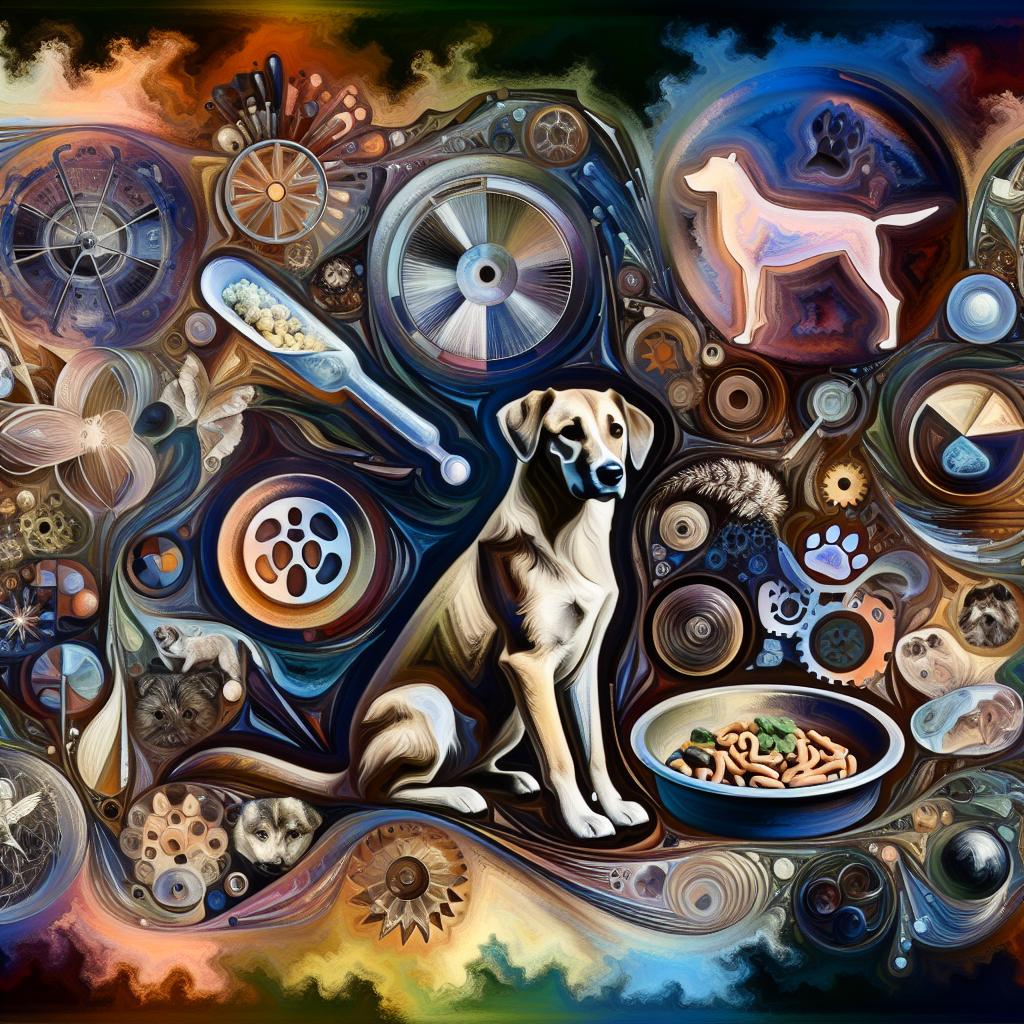Title: “Preventing Food Aggression in Dogs: Nurturing Harmony at Mealtime”
Introduction:
In the realm of pet ownership, few challenges spark concern quite like food aggression in dogs. As beloved members of our families, our furry friends bring joy and companionship into our lives—yet, when mealtime becomes a battleground, the bond can quickly turn tense. Understanding the instincts that underpin this behavior is essential for pet owners seeking to create a peaceful dining experience for both their canine companions and themselves. This article delves into the nuances of food aggression, from its origins rooted in survival instincts to practical, humane strategies for prevention and intervention. By cultivating an environment of trust and communication, we can foster a harmonious relationship that allows our dogs to enjoy their meals calmly and confidently, ensuring that every bite is a moment of joy rather than anxiety.
Understanding the Roots of Food Aggression in Dogs
Food aggression in dogs is often deeply rooted in their instincts and early experiences. Primarily, this behavior can be linked to survival tendencies, as dogs are descendants of wild animals that had to compete fiercely for food. In a domestic setting, these instinctual behaviors can be exacerbated by a variety of factors, including:
- Resource scarcity: Dogs that have faced food shortages may become more protective of what they perceive as limited resources.
- Past experiences: Negative experiences involving food, such as being bullied by other pets during mealtime, can lead to a heightened sense of vulnerability.
- Social hierarchy: Dogs may exhibit food aggression to establish dominance within a household or pack structure.
Understanding these underlying factors is crucial for pet owners seeking to mitigate food aggression. Recognizing the signs early allows for effective training techniques to be applied, such as:
- Controlled feeding practices: Establish consistent meal times and a designated feeding area.
- Positive reinforcement: Reward calm behavior during meals to encourage a sense of security and reduce anxiety.
- Desensitization: Gradually acclimate the dog to human presence near their food, helping to reduce their defensive reactions.
Effective Strategies for Counterconditioning Your Dog
Counterconditioning is a powerful technique to help change your dog’s emotional response to food-related situations, especially if they’ve shown signs of aggression. To begin, choose a controlled environment free from distractions where your dog feels comfortable. Next, incorporate high-value treats that your dog loves but doesn’t typically receive. Gradually introduce situations that previously triggered aggressive behavior while pairing them with positive experiences. For instance, while your dog is eating a safe treat, you could softly place another treat near them. It will help them associate the presence of people or other pets with positive outcomes rather than the fear of losing their food.
Implementing a consistent routine is crucial for success. Use the following strategies to support your efforts:
- Gradual Exposure: Slowly increase the proximity of triggers (like food bowls) while providing treats continuously.
- Desensitization: Regularly practice with your dog in various scenarios, like family meals, while reinforcing calm behavior.
- Reward System: Establish a clear system where calm behavior earns positive reinforcement, reinforcing their new behavior.
- Routine Feedings: Stick to set meal times to help your dog feel secure, knowing when their next meal will come.
Tracking your progress is also essential and can be easily done with the following table:
| Session | Trigger Introduced | Dog’s Response | Action Taken |
|---|---|---|---|
| 1 | Family member approaching | Growled slightly | Provided treats and praise |
| 2 | Dog near feeding bowl | Sniffed curiously | Continued rewarding calm behavior |
| 3 | Quiet environment | Calm and relaxed | Celebrated with more treat reinforcement |

Establishing Healthy Feeding Routines for Peaceful Mealtimes
Creating a consistent feeding schedule is essential for fostering a calm atmosphere during mealtimes. Dogs thrive on routine, and knowing when to expect their meals can alleviate anxiety and prevent food-related disputes. To establish a healthy feeding routine:
- Set Fixed Mealtimes: Aim to feed your dog at the same times every day, whether it’s once or twice daily.
- Use a Designated Feeding Area: Choose a quiet location free from distractions where your dog can focus on eating.
- Monitor Portions: Ensure you provide the right amount of food based on their breed, age, and activity level, preventing competition for resources.
- Introduce Consistent Training: Rewarding calm behavior before and during mealtimes can help reinforce a relaxed feeding environment.
Additionally, using slow feeders or puzzle bowls can redirect your dog’s focus during mealtimes, making the experience more engaging and less prone to aggression. Keep in mind that visual and olfactory stimuli can also contribute to excitement or anxiety during feeding. Here’s a simple table to highlight effective strategies:
| Strategy | Benefit |
|---|---|
| Consistent Timing | Reduces anxiety over food availability. |
| Designated Feeding Area | Minimizes distractions and interruptions. |
| Engaging Feeding Tools | Promotes slow eating and mental stimulation. |
| Behavioral Training | Encourages positive associations with mealtime. |

Creating a Safe and Stress-Free Eating Environment
Designing a nurturing space for mealtime is crucial for alleviating any feelings of stress or competition among dogs. Start by establishing a dedicated eating area that is free from distractions. This should be a quiet corner of your home where your dog can enjoy their meal undisturbed. Consider using non-slip mats or designated bowls that signify this space as their sanctuary during feeding. Incorporating elements such as soothing music or natural light can further enhance their comfort, making it a tranquil retreat rather than a battleground.
It’s also beneficial to create a predictable routine surrounding mealtimes. Consistency is key in reducing anxiety related to food. You might want to implement the following strategies:
- Set fixed mealtimes to establish a routine.
- Gradually introduce new foods to minimize surprises.
- Use positive reinforcement to reward calm behavior during meals.
In addition, consider employing strategies such as separating feeding areas when multiple dogs are present. This might involve using barriers or feeding them in different rooms to eliminate potential food-related conflicts. With patience and intentionality, you can foster a warm, stress-free atmosphere that encourages positive eating habits.
Q&A
Q: What is food aggression in dogs?
A: Food aggression is a behavior where a dog reacts defensively or aggressively when someone approaches their food bowl, food, or treats. This can manifest as growling, snapping, or even biting. It’s important to understand that this behavior is often rooted in fear or insecurity, rather than a natural inclination to guard food.
Q: What causes food aggression in dogs?
A: Various factors can contribute to food aggression, including past experiences of deprivation, competition for food during puppyhood, or inherent instincts inherited from wild ancestors. Dogs that have had to fight for resources may be more prone to exhibit aggressive behaviors around food.
Q: How can I identify if my dog is showing signs of food aggression?
A: Signs of food aggression can include growling, bared teeth, stiff body posture, and refusal to let anyone near their food bowl. Additionally, if your dog appears to be constantly vigilant or defensive while eating, these may also be indicators of food-related anxiety or aggression.
Q: What steps can I take to prevent food aggression?
A: Preventing food aggression involves several key strategies, such as:
- Desensitization: Gradually getting your dog used to having people near their food while they are calm.
- Positive Reinforcement: Rewarding your dog for good behavior around food, like allowing you to approach their bowl without reacting.
- Controlled Feeding: Feeding your dog in a quiet area where they feel safe, possibly with a crate or separate space initially.
- Resource Management: Using multiple bowls or toys to reduce competition among multiple pets in the home.
Q: Is it ever too late to change a dog’s food aggression behavior?
A: While it may take time and consistent effort, it is generally possible to modify food aggression behaviors in dogs of any age. Consulting with a professional dog trainer or a veterinary behaviorist can provide tailored strategies to help your specific situation.
Q: Should I be concerned if I witness food aggression in my dog?
A: Yes, food aggression can be a serious issue that poses risks not just to other pets or people but can also lead to increased anxiety for your dog. Addressing the behavior early can prevent it from escalating and help create a more harmonious household.
Q: Can certain types of training help alleviate food aggression?
A: Absolutely! Training methods such as obedience training, clicker training, and behavioral modification techniques can be particularly effective. These approaches focus on teaching your dog to associate positive experiences with your presence near their food, ultimately fostering trust and reducing aggressive tendencies.
Q: What role does socialization play in preventing food aggression?
A: Socialization is crucial in helping dogs feel secure in various environments, reducing anxiety around food. Introducing your dog to different people and animals in positive situations from an early age can help them build confidence and reduce resource-guarding behaviors.
Q: Are there any specific breeds more susceptible to food aggression?
A: While any dog can exhibit food aggression, certain breeds, particularly those with strong guarding instincts, may be more prone. However, individual temperament, upbringing, and experiences play a more significant role than breed alone.
Q: What should I do if my dog displays food aggression despite my efforts?
A: If your dog continues to show signs of food aggression, it is best to consult with a professional trainer or a veterinary behaviorist. They can assess the situation and provide personalized advice, ensuring the safety of both your dog and those around them.
—
Q: How can I ensure a positive feeding environment for my dog?
A: Creating a calm and stress-free feeding environment is essential. Consider establishing a routine, using calm, soothing tones when feeding, and avoiding distractions or interruptions during mealtime to help your dog enjoy their food without anxiety.
In Conclusion
addressing food aggression in dogs is not just about managing behavior—it’s about fostering a harmonious relationship built on trust and understanding. By implementing the strategies we’ve discussed, you can create a safe and reassuring environment for your canine companion, allowing them to thrive without fear of scarcity or competition. Remember, patience and consistency are your greatest allies on this journey. As you work together, you’ll not only help your dog feel more secure around mealtime but also strengthen the bond between you both. So, take a deep breath, embrace the process, and watch as your diligent efforts transform mealtime into a peaceful and enjoyable experience for everyone involved. Happy training!

